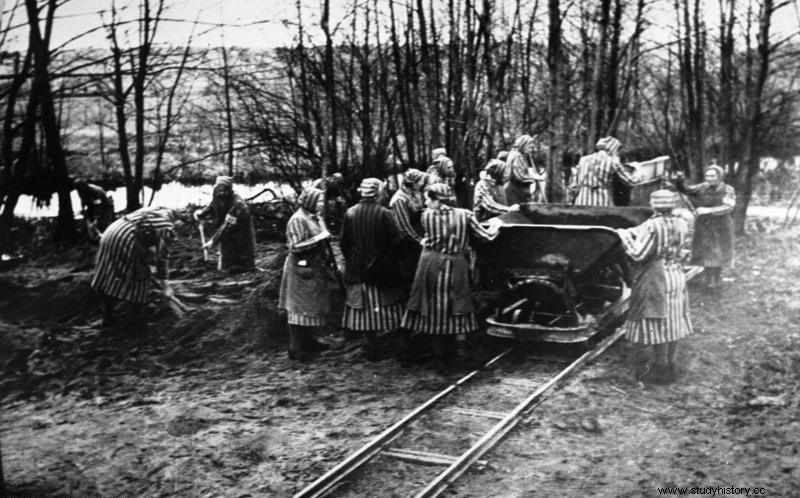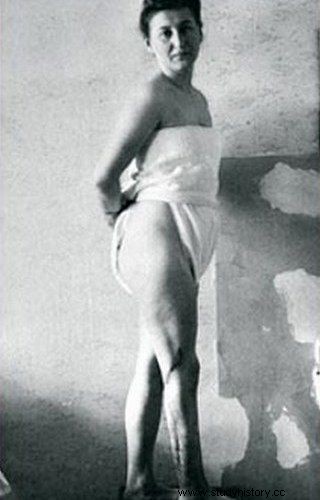He was a German criminal, he conducted cruel experiments on Polish women in a concentration camp. A Polish court sentenced him to death in absentia. The Americans were not going to let a hair fall off his head though.
If you value mass murder but also value your own skin, become a scientist, son. Nowadays, this is the only way to avoid being punished for murder - an American journalist sneered after the Second World War. Among the German criminals, scientists had the best chance of avoiding any responsibility.
Biologists, physicists and chemists were a kind of spoils of war for which Moscow and Washington competed. The Americans brought in over 1,600 German scientists , practically ignoring their past. Moreover, they even helped to hide it!
Criminal in Nuremberg ... as a witness
Doctor Walter Paul Schreiber was not a rank and file of the NSDAP, he was a war criminal like nothing. A professor of hygiene and bacteriology, representative of the Reich Scientific Council for Combating Epidemics, he dealt with plans to create biological weapons. He was also responsible for pseudo-medical experiments on prisoners of German concentration camps.

Joachim Mrugowsky in a photo taken during the Nuremberg trial (source:public domain).
The German did not limit himself to visiting the camps, watching the victims and receiving reports . In 1944, as a coordinator for hepatitis research, he himself asked Joachim Mrugowski, the chief hygienist of the Waffen SS, to assist in conducting human experiments.
Mrugowsky was tried in Nuremberg and executed, Schreiber also took part in the trial, but only as a witness. In 1945 he was captured by the Soviets. During the interrogation, the Soviets obtained information from him about German works on biological weapons. In Nuremberg, they wanted to read his testimony, but the judges insisted that the witness be heard in person. Schreiber was delivered to the scene and after interrogation returned to the East.

Walter Paul Schreiber testifies at the Nuremberg trial (source:public domain).
Too precious to hang
According to the testimony of subsequent witnesses and defendants, Schreiber was one of the main responsible for pseudo-medical experiments in the Third Reich. When the Soviets were asked to bring the criminal back to the tribunal, they began to dodge and make excuses. The matter was clear:Schreiber should have hung, but Stalin did not want to get rid of such a valuable scientist. He was not judged in the end.
Professor Schreiber, however, preferred to share his knowledge with the Americans. In 1948, he managed to get to the American occupation zone in Germany, where he started working for new principals. He struggled there with research questions like how to stuff the interrogated with drugs .
Three years later, an "intelligent and useful" physician was brought to the United States. On September 17, 1951, he and his family arrived in New York. Soon after, Schreiber began working at Randolph Air Base near San Antonio, Texas.
The truth comes out
Nobody would have found out about the German's past if it had not been for a coincidence. On November 14, 1951, a passenger ship with Janina Iwańska, a former prisoner of Ravensbrück, called at the port of New York.
In this German camp, 74 Polish women and over a dozen women of other nationalities fell victim to pseudo-medical experiments. Their legs were broken, their muscles were crushed, they were infected with gas gangrene, golden staphylococcus and tetanus, pieces of metal or earth were added to their wounds ...

The prisoners of the Ravensbrück camp, apart from slave labor, also fell victim to inhuman medical experiments. Among their torturers was Walter Paul Schreiber (source:Bundesarchiv; lic. CC ASA 3.0).
Iwańska herself had her legs broken, pieces of her tibia removed and she was infected with gangrene. She came to the United States for treatment. It was supposed to ease the pains she suffered from the camp ordeal.
In a hospital in Boston, a Polish woman talked about her stay in Ravensbrück with a doctor, Leo Alexander, who was an expert in the Nuremberg trial. The name of Walter Schreiber was mentioned - Iwańska remembered him as a doctor who visited the camp and assessed the progress of the mutilation of prisoners.

One of the former prisoners of Ravensbrück, mutilated during criminal experiments (source:public domain).
Alexander associated the surname from Nuremberg. Soon after, while browsing an industry medical journal, he found out that he had started working in Texas ... Walter Schreiber. A doctor from Boston immediately appealed to the authorities to release the German and deprive him of the right to practice. American officials remained deaf to requests for the criminal's release.
It must have been a different Schreiber!
The case shook - because it's hard to say that it moved - after a few months, when the famous columnist Drew Pearson dedicated an article to Schreiber. As Eric Lichtblau emphasizes in his book "Nazi Neighbors":
At first, the military defended Dr. Schreiber rather reluctantly. The colonel who was in charge of fetching the doctor claimed that the air force knew nothing of the horrific accusations made by American investigators in Nuremberg. He also said that regardless of this, the German doctor was the only eligible person for the tests he did in Texas.

After the war, hundreds of Nazi scientists went overseas. In 1952, prof. Schreiber. The photo shows part of the group of specialists in the field of missile weapons brought to the USA. There were also war criminals among them (source:public domain).
The scientist himself claimed that the attacks on him were inspired by communists, that the accusations were the result of similar names, that there must have been another Schreiber in Ravensbrück, that he had never seen Iwańska. Ba! That he was never in a concentration camp.
However, the Polish woman recognized him in the photo, remembered him coming to the camp and participating in the camp doctors' conferences. The numbers tattooed on my leg are T. K. M. III. If he doesn't remember my name, I'm sure he remembers the experiment number She said.
Schreiber continued to assert his innocence, although he changed his version slightly. He admitted he was in a concentration camp once, but claimed not to even know it was a concentration camp! The American military was constricted. They said: He is to blame only for serving his country or The evidence of guilt is inconclusive ... Later they tried to silence the case, get the criminal a job at the university.
Destination:Argentina
However, there were people who demanded justice. Dr. Leo Alexander and Alexander Hardy, one of the judges at the Nuremberg trial, wrote a letter to President Harry Truman. They showed that Schreiber was one of the co-responsible for medical experiments throughout the Third Reich. Janina Iwańska was just one of many victims!

Even after his expulsion from the United States, Schreiber did not even lose a hair of his head. He lived his days in peace in Argentinian Buenos Aires (source:public domain).
Authorities concluded that Schreiber could no longer be kept in the United States. If journalists were to pursue the topic further, it would seem that hundreds of German criminals were brought to the US who, for various reasons, were useful to America. This was done under Operation Paperclip.
No, Schreiber was not handed over to Germany, where he would face trial, or to Poland, where, according to American press reports, he was sentenced to death in absentia. The US Air Force helped him escape. The operation was top secret. In the spring of 1952, he was taken with his family on a military plane to New Orleans, and from there he went by sea to Argentina. The Americans got Schreiber all the necessary paperwork.

The knowledge he possessed allowed Schreiber to avoid the well-deserved punishment. There were many more like him. One of them was the father of the American space program, Wernher von Braun (source:public domain).
The German criminal spent the last years of his life in South America, dealing with genealogy and trying to find titled ancestors. He died in Buenos Aires in 1970, at the age of 77.
***
The story of Walter Paul Schreiber is convincing not only that knowledge is capital that sometimes helps save lives. He reminds that in international relations states are painfully selfish and unethical.
There is no solidarity, no decency, and beautiful cliche is only to justify the use of other countries. Both the Soviets and the Americans, if they saw benefits in it, were able to ensure impunity for the Nazi criminal. And many do.
Sources :
Basic:
- Eric Lichtblau, Nazi neighbors. How America became a safe haven for Hitler's people , Wydawnictwo Literackie, Krakow 2015.
- Alexander Puts Schreiber Crimes To Review by 'Highest Authority' , "The Harvard Crimson", February 15, 1952 [accessed September 26, 2015].
- How America helped Nazi experts on Soviet Union , The Glasgow Herald, February 21, 1983.
- Linda Hunt, U.S. coverup of Nazi scientists , "Bulletin of the Atomic Scientists", April 1985.
- Jacobsen Annie, Operation Paperclip. The secret intelligence program that brought Nazi scientists to America , Little &Brown, New York 2014.
- Janina Iwanska - Schreiber photo used to identify , "The Waco News-Tribune," February 15, 1952.
- Alfred W. McCoy, Science in Dachau's Shadow:Hebb, Beecher, and the Development of CIA Psychological Torture and Modern Medical Ethics , "Journal of the History of the Behavioral Sciences", vol. 43 (2007), issue 4.
- Jonathan E. Moreno, Under Risk. Secret State Experiments on Humans , Routledge, New York 2001.
- New York, New York Passenger and Crew Lists, 1909, 1925-1957, database with images, 8039 - vol. 17588 17590, Sep 17, 1951, image 256 of 1554; citing NARA microfilm publication T715 (Washington, D.C .:National Archives and Records Administration, n.d.), [in:] FamilySearch.org, [accessed:25 September 2015].
- Dean Pearson, Air Force Hires Nazi Doctor Linked to Ghastly Experiments , "The Free Lance-Star," February 14, 1952.
- Stanisław Sterkowicz, Criminal medical experiments in concentration camps of the Third Reich , Ed. MON, Warsaw 1981.
- Trial of the Major War Criminals before the International Military Tribunal , vol. 21, Proceedings August 12, 1946 - August 26, 1946 , Nuremberg 1948, [accessed September 26, 2015].
